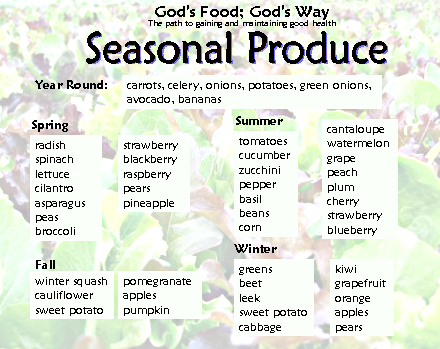Yum. Fresh raspberries and peaches from our yard and some local blueberries. I love summer foods. I also love pomegranates in the fall, grapefruit and oranges in the winter, and strawberries in the spring. These are just a few of the many, many different fruits I enoy. Fresh fruit in season is God's candy!
If you eat the produce that is in season, you will be eating better quality fruits and vegetables, you will save money, and they will taste better. While all of these things are great, I think the most important reason is that you will optimize your health because your body will receive the nutrients it needs with each season. For example, different nutrients are needed during a cold winter (lots of Vitamin C to prevent colds) and the hot summer (cooling fruits loaded with antioxidants). This is the plan God created to keep us healthy.
How to buy the produce that is in season (typically):
1. Choose the produce that is on sale.
2. Find the produce that is on the end caps (which is often also where the sales items are).
3. Pick the produce that looks good.
4. Buy local produce that is available.
The produce that is in season is dependent upon where you live. If you live on the opposite side of the equator from me, your seasons are reversed. While you can buy all produce year-round now, the produce that was picked long before it was ripe and shipped halfway around the world is not going to taste very good. Enjoy the local foods that grow close to where you live.
This is a chart for seasonal produce in the south central portion of the United States. I created the chart for a class I taught five years ago. The beauty of God's foods is that they don't change so this chart is still valid; what changes is man's constant alteration of God's foods which is very frustrating (like the genetic modification of foods, GMO foods, which will be the topic of another post). Keep in mind, that the produce that is available each season varies year-by-year depending on the weather. For instance, some years there are lots of oranges and grapefruit available, but years when freezes damage the crops, little is available. Also, I call March into April the 'dry season' for produce, because it is between the winter and summer crops and not much is available. But soon all of the delicious summer fruits and vegetables are plentiful, such as strawberries, grapes, peaches, plums, cantaloupe, watermelon, tomatoes, cucumber, zucchini, etc. Summer is the time of year to eat a wonderful variety of fresh produce. Remember to also include fresh herbs in your diet. Basil, parsley, rosemary, thyme, oregano, dill and sage are all easy to grow in this area.
The freshest produce that you can eat is what you grow yourself. Buy a tomato plant this spring and put it in a bed in your yard or in a large pot on your patio. Plant your herbs in among your flower beds. Zucchini, cucumbers, cantaloupe, pumpkins, okra, winter squashes and many other things are very easy to grow from seed. If you grow your own produce, be sure to grow it organically and do not use chemical fertilizers, herbicides, or pesticides on your yard. Maintaining your yard organically is healthier for your family members, who are walking or playing in your yard, and for the environment.
Google the topic of seasonal produce for your area and you will find many sites with more information. When possible, find local sources of your produce. Produce that is grown close to you does not have to be picked before it is ripe and will taste so much better. Enjoy!
"There is a time for everything, and a season for every activity under the heavens" Ecclesiastes 3:1



coming from a background of living in the central valley of California, we had rows and rows of fresh fruit and veggies. I never had to think about what was in season, I'd just step outside and see whats growing. But now all my shopping is done in the stores and who know how far produces travels. I'm planning a patio veggies garden for the spring. There's nothing like a truly vine ripen tomato!
ReplyDelete